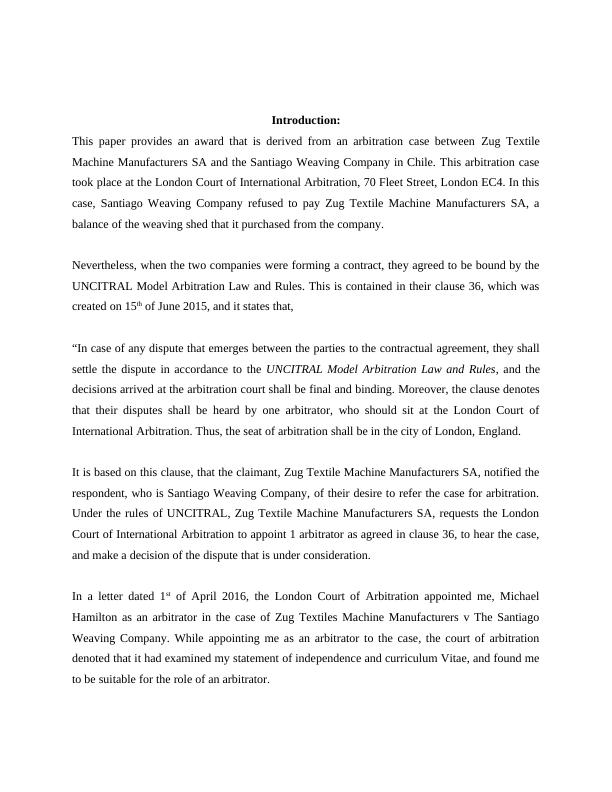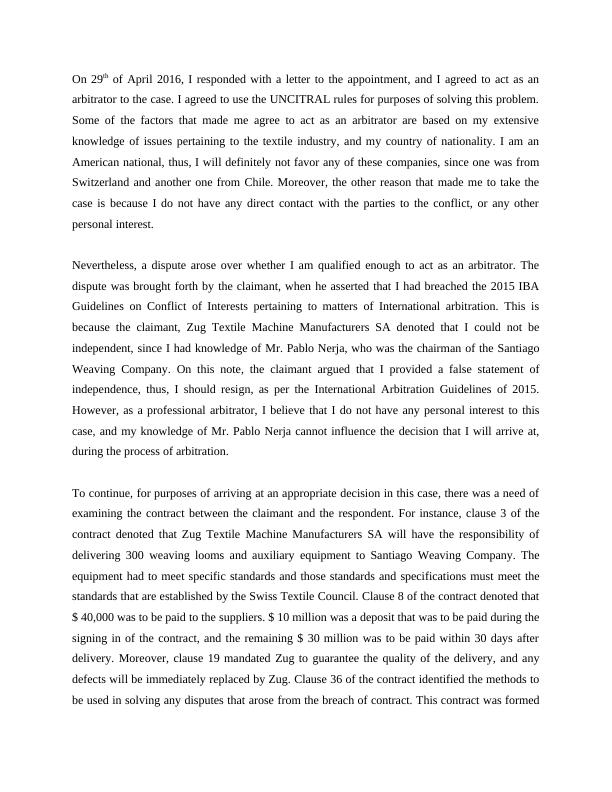Paper on Arbitration Case
4 Pages1401 Words130 Views
Added on 2020-02-24
Paper on Arbitration Case
Added on 2020-02-24
ShareRelated Documents
Introduction:This paper provides an award that is derived from an arbitration case between Zug TextileMachine Manufacturers SA and the Santiago Weaving Company in Chile. This arbitration casetook place at the London Court of International Arbitration, 70 Fleet Street, London EC4. In thiscase, Santiago Weaving Company refused to pay Zug Textile Machine Manufacturers SA, abalance of the weaving shed that it purchased from the company.Nevertheless, when the two companies were forming a contract, they agreed to be bound by theUNCITRAL Model Arbitration Law and Rules. This is contained in their clause 36, which wascreated on 15th of June 2015, and it states that, “In case of any dispute that emerges between the parties to the contractual agreement, they shallsettle the dispute in accordance to the UNCITRAL Model Arbitration Law and Rules, and thedecisions arrived at the arbitration court shall be final and binding. Moreover, the clause denotesthat their disputes shall be heard by one arbitrator, who should sit at the London Court ofInternational Arbitration. Thus, the seat of arbitration shall be in the city of London, England. It is based on this clause, that the claimant, Zug Textile Machine Manufacturers SA, notified therespondent, who is Santiago Weaving Company, of their desire to refer the case for arbitration.Under the rules of UNCITRAL, Zug Textile Machine Manufacturers SA, requests the LondonCourt of International Arbitration to appoint 1 arbitrator as agreed in clause 36, to hear the case,and make a decision of the dispute that is under consideration. In a letter dated 1st of April 2016, the London Court of Arbitration appointed me, MichaelHamilton as an arbitrator in the case of Zug Textiles Machine Manufacturers v The SantiagoWeaving Company. While appointing me as an arbitrator to the case, the court of arbitrationdenoted that it had examined my statement of independence and curriculum Vitae, and found meto be suitable for the role of an arbitrator.

On 29th of April 2016, I responded with a letter to the appointment, and I agreed to act as anarbitrator to the case. I agreed to use the UNCITRAL rules for purposes of solving this problem.Some of the factors that made me agree to act as an arbitrator are based on my extensiveknowledge of issues pertaining to the textile industry, and my country of nationality. I am anAmerican national, thus, I will definitely not favor any of these companies, since one was fromSwitzerland and another one from Chile. Moreover, the other reason that made me to take thecase is because I do not have any direct contact with the parties to the conflict, or any otherpersonal interest. Nevertheless, a dispute arose over whether I am qualified enough to act as an arbitrator. Thedispute was brought forth by the claimant, when he asserted that I had breached the 2015 IBAGuidelines on Conflict of Interests pertaining to matters of International arbitration. This isbecause the claimant, Zug Textile Machine Manufacturers SA denoted that I could not beindependent, since I had knowledge of Mr. Pablo Nerja, who was the chairman of the SantiagoWeaving Company. On this note, the claimant argued that I provided a false statement ofindependence, thus, I should resign, as per the International Arbitration Guidelines of 2015.However, as a professional arbitrator, I believe that I do not have any personal interest to thiscase, and my knowledge of Mr. Pablo Nerja cannot influence the decision that I will arrive at,during the process of arbitration.To continue, for purposes of arriving at an appropriate decision in this case, there was a need ofexamining the contract between the claimant and the respondent. For instance, clause 3 of thecontract denoted that Zug Textile Machine Manufacturers SA will have the responsibility ofdelivering 300 weaving looms and auxiliary equipment to Santiago Weaving Company. Theequipment had to meet specific standards and those standards and specifications must meet thestandards that are established by the Swiss Textile Council. Clause 8 of the contract denoted that$ 40,000 was to be paid to the suppliers. $ 10 million was a deposit that was to be paid during thesigning in of the contract, and the remaining $ 30 million was to be paid within 30 days afterdelivery. Moreover, clause 19 mandated Zug to guarantee the quality of the delivery, and anydefects will be immediately replaced by Zug. Clause 36 of the contract identified the methods tobe used in solving any disputes that arose from the breach of contract. This contract was formed

End of preview
Want to access all the pages? Upload your documents or become a member.
